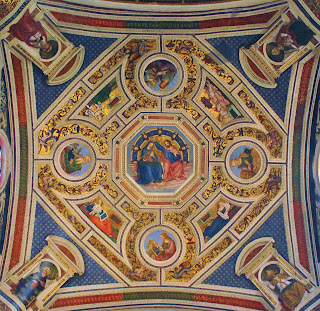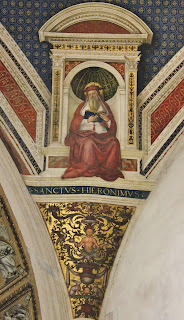The choir of Santa Maria del Popolo.

Today I was granted permission to visit the beautiful coro of this Basilica, it is not only one of the main areas within the basilica but it is also decorated by some of the greatest artists present in Rome during the early 1500s.
Pope Julius II after his election in 1503 dedicated himself to the enlargment and embellishment of the choir of the Basilica - it had already been restored by Bramante at the turn of the century who made it monumental by commission of Cardinal Ascanio Sforza. Bramante worked on the choir in two different phases - the first (1500) modelling the apse, the second (1505-1509) modifying the vaulting. Afterwards, two funerary monuments were added, the one of Cardinal Ascanio Sforza and the one of Cardinal Girolamo Basso-Della Rovere, both by Andrea Sansovino.
The four evangelists.
The frescoes, by Pinturicchio, were initially commissioned by Cardinal Sforza, but after his death Pope Julius II continued to promote the project. Pinturicchio was by this time a mature artist and his work was defined as "bellissimo" in what we would now call a sort of art magazine of the time, by Francesco Albertini.
The four sybils.
The Pinturicchio frescoes represent the Coronation of the Virgin surrounded by the four evangelists, those who brought Christ to us, four sibyls, a Renaissance reminder to those who first foresaw the coming of Christ, and four doctors of the Church, those who made God's mystery known unto mankind. It is a geometrical composition based on the one of the Domus Area - the background is filled with refined grotesques. It has a strong theological meaning based on the centrality of Mary's figure, her being sorrounded in fact, by both the doctors of the church and more closely by the evangelists in her heavenly throne.
The four doctors of the Church.
Detail of the Grotesques.
The gilded background is made of mosaics which we can find also in Pinturicchio's work in Sant'Onofrio al Gianicolo or similarly in the golden leaf background of the leading artist of the early Roman Renaissance: Antoniazzo Romano - this was clearly Rome's touch to it!
The apse by Bramante.
The tombs by Francesco Albertini.
Another interesting detail are the stained glasses, representing the lives of Christ and Mary - both are by Guillaume de Marcillat (1509) and are his first work in Rome.
The stained glass windows by Guillaume de Marcillat.
The Coronation of the Blessed Virgin Mary.
The whole ceiling.























Hello, I am a professor of art history, and I have a question about possibly using the photographs of the choir in Santa Maria del Popolo in an academic publication. The publication is not for profit and attribution would be given to the photographer. You can find out about my research and contact me through academia.edu: https://txstate.academia.edu/KathrynBlairMoore
ReplyDeleteThank you!
Hello, sorry for the late response, it would be a pleasure, I know how difficult it is to find good photographs of Renaissance artworks in Rome online. Could you please send me the link eventually? Good luck with your research! And thank you for mentioning me. I will never say no to polite requests. Edoardo
DeleteHello,
ReplyDeleteBeautiful photo´s and a very interesting article! I was wondering if you can help me with (academic) literature about the ceiling made by Pinturicchio? I hope to hear from you.
Thank you!
Would be very happy to help! Would you mind sending me an e-mail here office@allsaintsrome.org? Thank you!
DeleteHello! Would very much like to use one of your photos of Marcillat's Nativity of the Virgin for a not-for-profit publication. You can check out my credentials via my name. Thank you!
ReplyDelete